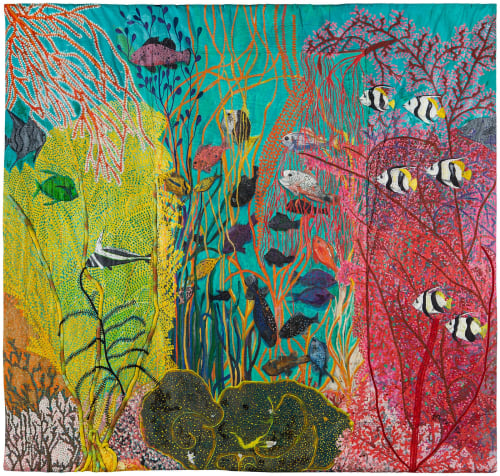The Art Gallery of Ontario (AGO) in Canada is currently presenting Pacita Abad, the Canadian leg of the first major retrospective by the eponymous Filipino-American artist (1946 - 2004), from October 9, 2024 - January 19, 2025. The solo show spans Abad’s career of 32 years, bringing together over 100 works, including painting works, prints and the technique of trapunto (traditional Italian quilts), which she used to create colourful quilted paintings that were embellished with accumulated materials, addressing various political topics through her work. Pacita Abad is organised by the Walker Art Center, Minneapolis, in collaboration with the artist’s estate, and is curated by Victoria Sung, Phyllis C. Wattis Senior Curator, Berkeley Art Museum and Pacific Film Archive, and curatorial fellow Matthew Villar Miranda from the Visual Arts department at Walker Art Center. The AGO presentation is organised by Renée van der Avoird, associate curator of Canadian art, AGO, in collaboration with Carla Felix, community outreach advisor. Van der Avoird joins STIR for an interview that explores the artist’s perspective on transforming the language of quiltmaking and how she channelled her global inspirations.
Pacita Barsana Abad was born in Batanes, Philippines and became politically active during her youth. She migrated to the United States in 1970 to escape persecution by the infamous Marcos regime (1965 - 1986), which saw the nation under martial law from 1972 to 1981. An inveterate traveller, she visited over 60 countries in her lifetime, subsuming the crafts she encountered on her journeys into her practice. Her influences ranged from Indonesian batik printing to Korean beadwork, but it was perhaps medieval Italian quiltmaking that left the deepest impression on her. 'Trapunto', as it is known, became Abad’s signature technique. This style of quiltmaking involves a design being added into a quilt through stitching, followed by stuffing being pushed into that particular portion from the back of the quilt to raise it.
Western art has traditionally held a gendered prejudice against quiltmaking—and more broadly textile work—which it has pejoratively associated as “women’s work”. The AGO curator addresses Abad’s focus on textile-based art, telling STIR, “...we can interpret Abad’s commitment to quilting and needlework as a strategy of resistance to traditional art forms of Western modernism…By embracing (textiles) in her practice, Abad broke down barriers between fine art and functional art.”
Many of the works at the exhibition highlight the artist’s global and pluralistic approach towards artmaking. As an example, Van der Avoird references the trapunto, pointing to the series Masks from Six Continents (1990 - 1993). She says,“[This series was] originally on view over 30 years ago at the Metro Center transit station in Washington DC [and] these immense textile works reference [maskmaking] cultures from Oceania, South America, Africa, and Asia.” She explains that this series presents an interconnected vision of a more equitable world and that the artist developed it through careful observation of mask-making traditions with ceremonial and artistic contexts.
—Manu Sharma


